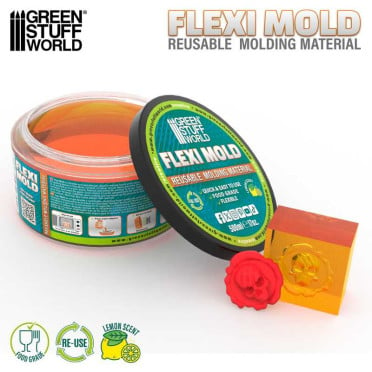Flexi Mold is a superior alternative to silicone because it offers several distinct advantages over traditional silicone molds:
- Performance: It is reusable, which significantly reduces material costs over time.
- Environmental Safety: Being biodegradable and free of harmful chemicals makes it a safer choice for the planet.
- Correctable: If a mistake is made, it can be remelted and remolded without wasting material.
- Ease of use: Unlike silicone, it requires no mixing or curing agents, simplifying the process.
- Food grade: It can be used in the process of culinary elaborations.
Important usage advice: This product should only be heated in microwave-safe containers, such as the product packaging, in which it comes. The use of incompatible containers could melt them and even damage the product generating unsafe handling conditions.
- Melting: Heat it until it becomes a liquid. To do this, you can use the microwave, always in short heating intervals 10-15 seconds 2-3 times, or a bain-marie. If it is heated all at once in the microwave, it may burn.
- Pour: Pour the molten material over your object or into a casting box in which to make your mold.
- Cool: Allow it to solidify completely by letting it cool to room temperature or refrigerate it for faster results.
- Reuse: When no longer needed, reheat the product to reshape it or create a new one.
Precautions when using resin with Flexi Mold
- Resin generates heat during curing, so there are several things to keep in mind before using it.
- Size: Larger projects tend to produce more heat due to the larger volume of resin that reacts. This is why you should only use it on small projects. Otherwise, the accumulated heat will damage the mold as it could eventually melt it.
- Ambient temperature: Ambient temperatures affect the prolongation or reduction of the curing process of these materials.
- Resin type: Different resins have different curing characteristics, including the amount of heat they release. Consult the manufacturer's manual for proper cure. Additives: Additives such as pigments or fillers can affect the curing process.
- Cooling: When using these materials, which work with temperature, it is advisable to let them cool completely.
| Product Type | Game sets, Painting/Modelling | |
| Country of origin | Spain | |
| Editor | Green Stuff World | |
| EAN | 8435646527949 |
Soyez le premier à commenter ce jeu
Vous devez être identifié pour soumettre des avis.
Copyright © 2025 www.philibertnet.com Legals - Privacy Policy - Cookie Preferences - Sitemap







